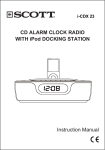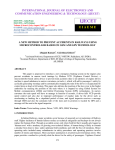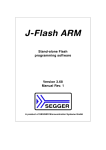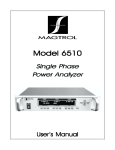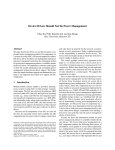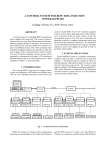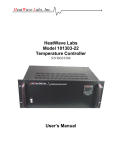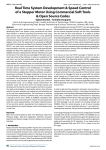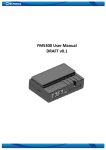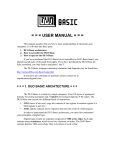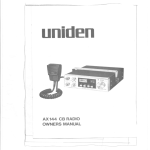Download IDC cable Test Jig
Transcript
ISSN : 2230-7109 (Online) | ISSN : 2230-9543 (Print) IJECT Vol. 6, Issue 4, Oct - Dec 2015 IDC cable Test Jig Abhilash Mudigonda Dept. of ECE, Vignan University, Guntur, AP, India Abstract In Electronics and Electrical Engineering Industry, FRC and IDC cables play a major role in data transfer. A major challenge lies in failure of these cables. It could be either loss or excess of data flow or it could be data corruption due to mishandling or damage in these lines. This issue may arrive while manually installing connectors over these cables, and this happens to be a stumbling block to overcome now a days. As a consequence, a lot of reverse engineering is being done in order to trace the problem and many ribbons are being sent back for reinstallation which might cause wastage of time and even material. So, at least to predict the error at the installation stage itself would reduce the time wastage and could also bring out the alertness to install properly. It could be a better choice to choose a controller based circuit for its flexibility to test in with many logics. The objective of IDC cable test jig is to test the functionality of these FRC and IDC Ribbons using a micro controller circuit which would provide flexibility to test various bit connectors and indicate whether installation is done properly. Outline of the logic: Giving bit1 to all pins except one pin, that pin is assigned 0. Then if that pin is shorted with any other pin, the output becomes 0. Similarly, this operation is iterated for the remaining 64 bits and outcome is compared with the recorded input sequence. Keywords IDC cable, Test Jig, ARM 7 processor, Latches, Multiplexers. I. Introduction An Insulation Displacement Cable (IDC), also known as multiwire planar cable (shown in Fig below) is a cable with many conducting wires travelling parallel to each other on the same flat plane. It is used very frequently in many electronic devices and machines for continuous transmission of data. Because the cable is compatible to all the equipment and flexible to any atmosphere, the utility of it became common. These ribbon cables are mainly used in internal peripherals of devices, computers and much other machinery. The wires of the cable are closed and protect the data when passed throughit. Each wire of the cable is independent of other wires though they are attached together. It consists of two female connectors at both the ends, through which it can be connected to male connectors of the device. These ribbons are of various types depending upon the number of wires attached to each other. These various types can be use according to our requirement. In many electronic firms where these cables are used for data transmission with their end points crimped with connectors. There are different ways to crimp the connectors over the cables. Automated crimping and manual crimping.In case, manual crimping is used, there could be a possibility of error. II. Problem and Objective A. Problem The only problem faced by the user with the IDC ribbon is whenever the wires of the ribbon gets Short circuit to each other or gets open 68 International Journal of Electronics & Communication Technology at any place throughout the ribbon, one cannot identify the short or open without opening the connectors. If the short or open is to be traced, the user must open the connectors on either side of the ribbon and manually check the pins for problem. This consumes the precious time of the user and is also a bit complicated work. B. Objective To build a circuit in order to test the functionality of the FRC and IDC cables, this would predict the error at the installation stage and reduce the possibility of rework. III. Initial Design Thought The risk of verifying the problem in the ribbon manually can be reduced by using the test jig prepared by me. Using this jig, user can test the ribbon by just inserting into the male connector of the jig and can know the type of problem (either short or open) and also place of problem within no time. The test jig is very simple to assemble and the cost of making it is very cheap since it is made with simple components. After experimenting with high level components to make the testing of IDC cables automatic, we learnt that this can be made too easy even with basic components. The material used to make the test circuit is a general purpose PCB, IC 7486 (XOR gate), resistors (value depends on the voltage used, but generally need 200 ohms for 5v source) 3 mm. LEDs and a male connector. A. Construction Connector XOR gate Resistors LED Indicators Fig. 1: Block Diagram Along With Initial Circuit Here in the test jig, the odd pins of male connector in the circuit are given logic ‘1’ and evenpins are given logic ‘0’ (here ‘1’ indicates +5v and ‘0’ indicated GND). From the same connector, pin 1is connected to first pin of IC 7486 and pin 2 is connected to second pin of IC. Now, the third pin of theIC is connected to LED via resistor. In the same way, pin 3 of connector is connected to fourth pin of theIC and pin 4 to fifth pin. Sixth pin of the IC is connected to LED through a resistor.The basic blockdiagram is shown in Fig and its soldered circuit is shown in figure. These connections continuous according to the number of wired ribbon used. The negative end of the LED will be grounded. Thenumber of ICs required depends on the number of wires present in the ribbon. w w w. i j e c t. o r g ISSN : 2230-7109 (Online) | ISSN : 2230-9543 (Print) B. Working The basic logic behind this circuit can be understood by knowing the truth table of XOR gate shown. By inserting the female connector of the ribbon into the male connector of test jig, due to the connections i.e. logic ‘1’ to odd pins and logic ‘0’ to even pins, the input of XOR gate appear as ‘1’ and ‘0’ which makes the output of ‘1’ and makes the LED glow. If there exists any short or open, the inputs will be either ‘1’ and ‘1’ or ‘0’ and ‘0’, which makes the output ‘0’ and the LED does not glow. This indication of the LED not glowing resembles problem in the pins of the ribbon wires connected to that particular LED via IC. IJECT Vol. 6, Issue 4, Oct - Dec 2015 purposes. These micro-controllers incorporate a 10/100 Ethernet MAC, USB 2.0 Full Speed interface, four UARTs, two CAN channels, an SPI interface, two Synchronous Serial Ports (SSP), three I2C interfaces, an I2S interface, and a Mini Bus (LPC2378 only: 8-bit data/16-bit address parallel bus). Fig. 3: ARM7 LPC2368 Micro-controller Fig. 2: Ex-OR gate and its Truth Table C. Limitations 1. The major drawback of this circuit is it cannot withstand the power fluctuations and Vcc load. 2. As the pins get short, Vcc and ground get connected to each other, eventually the circuit fails and hence its components. This makes the experiment a complete failure. 3. The other limitation is its complexity. Usage of so many IC’s increases the complexity andhence the circuit seems bulky. 4. The circuit is also a rigid one. Only, a rigid logic could be applied and multiple tests cannot be performed. IV. Micro-Controller based Test Jig The alternate approach could be usage of a micro-controller driven circuit. The circuit consists of data directing components such as latches and multiplexers. The primary idea of the circuit is to send data to one end of the ribbon and collect the data from other end back to the controller. The core logic of the test jig lies here. Because, by sending to and reading back the data status of the ribbon pins could be easily found out. The components mainly used in this circuit are: 1. ARM7 (LPC 2368) micro-controller. 2. 74HC 574 latches. 3. 74 HC 151 dual multiplexers. 4. Connecting wires, coupling capacitors (as per requirement). A. LPC 2368 ARM7 Micro-controller LPC2364/6/8/78 is an ARM-based micro-controller for applications requiring serial communication for a variety of w w w. i j e c t. o r g B. 74HC574 Octal D-latch The M74HC574 is an high speed CMOS octal D-type latch with 3-state outputs inverting fabricated with sub-micron silicon gate C2MOS technology. This 8 bitD-TYPE FLIP FLOP is controlled by a clock input (CK) and an output enable input (OE). On thepositive transition of the clock, the Q outputs will be set to the logic states that were setup at the D inputs. While the OE input is at low level, the eight outputs will be in a normal logic state (high orlow logic level) and while OE is in high level the outputs will be in a high impedance state. The outputcontrol does not affect the internal operation of flipflops; that is, the old data can be retained or the newdata can be entered even while the outputs are off. All inputs are equipped with protection circuitsagainst static discharge and transient excess voltage Fig. 4: 74HC574 Octal Latch Pin Diagram C. 74 HC151 Dual Multiplexer The M74HC151 is a high speed CMOS 8 channel multiplexer fabricated with silicon Gate C2MOS technology. It provides, in one package, the ability to select one bit of data from up to eight sources. The M74HC151 can be used as a universal function generator to generate any logic function of four variables. Outputs Y and W are complementary; the selection depends on the address inputs A, B, and C. The strobe input must be taken low to enable this device, when the strobe is high output is forced high and International Journal of Electronics & Communication Technology 69 ISSN : 2230-7109 (Online) | ISSN : 2230-9543 (Print) IJECT Vol. 6, Issue 4, Oct - Dec 2015 consequently Y output goes low. All inputs are equipped with protection circuits against static discharge and transient excess voltage. Fig. 5: 74HC151 8*1 Dual Mux Pin Diagram D. Testing for 64-pin FRC Connector Ribbon Giving bit 1 to all pins except one pin, that pin is assigned 0.Then if that pin is shorted with anyother pin, the output becomes 0.Similarly, this operation is iterated for the remaining 64 bits and outcome is compared with the recorded input sequence. For instance, if there is a short between pin 51 and pin 52 and during iteration bit 0 is applied to pin 51, and then output would be 0 for both pins. Hence we can say that there is a short between pins 51and 52. If there is any error in continuity. i.e., when bit 1 is given to all the pins and output collected is not the same then continuity could be predicted. The circuit elements could probably be, Eight 74574 latches for reading the input and nine 8*1 multiplexers connected to output to read it back to the controller circuit. E. Design Criteria The circuit is designed as per the stipulated data flow driven from the micro-controller card. The micro-controller accesses data from a 40-pin connector which is a collection of certain port pins. Utilization of those port pins sums up partial design of the circuit. The micro-controller is only responsible for accessing the data and further processing it, the rest of data flow must be controlled and regulated by the circuit elements. i.e., here the elements are multiplexers and latches. Here, we need to send data to 64 latch pins butwe have only 8 port pins to access. Hence we send the data to the latches commonly and read from them by varying the clock pins. The construction of the receiving end is related with the multiplexer set. Here, eight multiplexers are placed to read the ribbon status and send back to controller for comparing the output and input. The 64 bits are redirected to the eight multiplexers and the output of eight multiplexers is again connected to another multiplexer, and the final output bit pin is connected to the port pins set. F. Working Firstly, when the controller is on, and ribbon is placed, a bit sequence of 000000FE is passed. i.e., first pin is set 0 and remaining pins are set 1 and this data is read to the ribbon and clockpins are set as the same 00000001, i.e., first latch is clock enabled and soon after that data is set, the latch bits are set with all bit 1’s, i.e., 000000FF, and next all the remaining latches are clock enabled. So that first bit is set 0 and remaining 63 bits are set 1 and the data is accessed. For example, if input sequence is 1111011, and if the pin bearing bit0 is shorted with the adjacent pin, the output could be 1110011. Now, the XOR comparison result would be 0001000. Now the obtained output is sorted out to find out the faulty pin. Here if the bit 1 is present in i’th position, then that pin number is said to be the faulty bit. G. LCD Panel Circuit The obtained result is to be displayed on an LCD display. The LCD display used is a 24*2 LCD panel, which implies that the character length is 24 and comprises of 2 rows. The LCD panel is interfaced to the controller through a 26-pin connector. Requirements for LCD interfacing circuit are a 24*2 character length LCD panel and a 10K Potentiometer (POT). The condition of the IDC cable would be displayed on the LCD panel as “Faulty” with corresponding pin number and type of the fault or if the cable is alright then it will be displayed as “No fault”. F. Circuits The below shown block diagram is in detail explained in the following circuit block Diagram to test a 64-pin connector. Power supply LCD Panel LPC 2368 ARM 7 Controller card (along with peripherals) 74574 Latches Connector with IDC ribbon 74HC151 Multiplexers Fig. 6: Block Schematics for IDC Cable Test Jig 70 International Journal of Electronics & Communication Technology Fig. 7: LPC 2368 Micro-controller card along with peripherals w w w. i j e c t. o r g IJECT Vol. 6, Issue 4, Oct - Dec 2015 ISSN : 2230-7109 (Online) | ISSN : 2230-9543 (Print) Fig. 8: Latches and Multiplexers Connected as Per Block Diagram Fig. 9: Part of Circuit Showing Connectors where the IDC Cable Needs to be Placed. H. Flow Chart I. Testing Observations The test Jig was tested with various data cables by making deliberate faults such as shorting two pins and then three pins. The output was as expected. It was also tested for discontinuity and got desired results. Start Initialize LCD display Table 1: Observations for IDC Cable Test Jig With Multiple Combinations of Errors Produced in Cable Display “Insert IDC cable” Send Input sequence to the connector through latches Read back the data from the other end through multiplexers Compare Input and Output sequences If Input sequence = Output sequence Display: “Faulty cable and error at pin number: Type of fault: Short/Open End w w w. i j e c t. o r g Type of Error No of bits 1 Open 2 2 Open 3 3 Open 4 4 Short 2 5 Short 3 Yes Display in LCD panel: “No fault present” No S.no Message displayed on LCD screen Faulty cable and error at pin number 41,42 Type of fault: Open Faulty cable and error at pin number 52,53,54 Type of fault: Open Faulty cable and error at pin number 11,12,13,14 Type of fault: Open Faulty cable and error at pin number 12,13 Type of fault: Short Faulty cable and error at pin number 24,25,26 Type of fault: Short J. Future Scope This test jig can be further modified to suit data cables of different bits.ie. 32 bit, 16 bit etc. Input devices can also be provided to give various sets of sequences to the data cables. V. Conclusion The proposed system IDC Cable Test Jig is tested successfully by shorting one bit with another and one bit with all other bits and also by providing deliberate discontinuity in the cables. The IDC Cable Test Jig is tested for various combinations of short and open circuit and it provided expected results for majority of the scenarios. International Journal of Electronics & Communication Technology 71 IJECT Vol. 6, Issue 4, Oct - Dec 2015 This test jig is further modified and tested for different buses and wiring harnesses and got expected results. References [1] ARM user development guide [2] ARM System Development Guide by Andrew Sloss, Dominic Symes, and Chris Wright. [3] LPC 23XX user manual-NXP Semiconductors. [4] C and C++ für Embedded Systems by Friedrich Bollow, Matthias Homann, Klaus-Peter Köhn [5] LPC 23XX Data sheet-NXP Semiconductors. [6] UV4- Getting Started with KEIL-user guide. 72 International Journal of Electronics & Communication Technology ISSN : 2230-7109 (Online) | ISSN : 2230-9543 (Print) Abhilash Mudigonda received his B.tech degree in Electronics and Communication Engineering from Vignan University, Guntur, AP, India, in 2013. He worked as an Intern at Efftronics Systems Private Limited, Vijayawada, India. He is currently working as System Engineer in Tata Consultancy Services – Engineering and Industrial Services (TCS-EIS). His interests include Embedded Systems especially in the field of Automobiles. He is also interested in Industrial Automation and Applied Electronics. w w w. i j e c t. o r g





